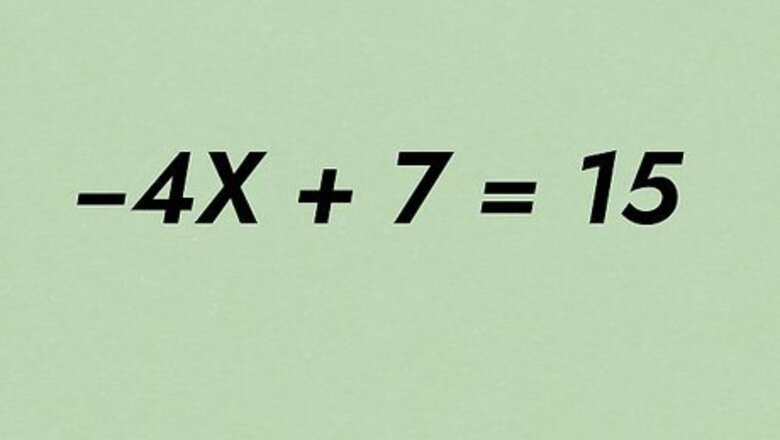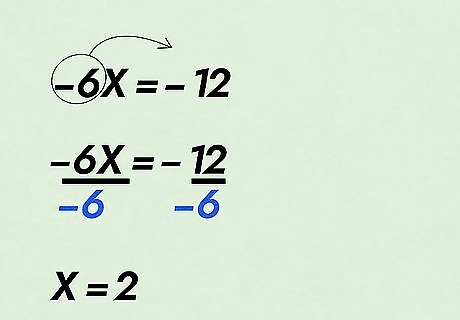
views
Solving Equations with One Variable

Write the problem. The first step to solving a two step algebraic equation is just to write the problem so you can start to visualize the solution. Let's say we're working with the following problem: -4x + 7 = 15.

Decide whether to use addition or subtraction to isolate the variable term. The next step is to find a way to keep "-4x" on one side and to keep the constants (whole numbers) on the other side. To do this, you'll have to do the "Additive Inverse," finding the opposite of +7, which is -7. Subtract 7 from both sides of the equation so that the "+7" on the same side as the variable term is canceled out. Just write "-7" below the 7 on one side and below the 15 on the other so the equation remains balanced.Remember the Golden Rule of Algebra. Whatever you do to one side of an equation must be done to the other side to maintain the balance. That is why 7 is subtracted from the 15 as well. We only need to subtract 7 once per side, which is why the 7 is not subtracted from the -4x as well.

Add or subtract the constant on both sides of the equation. This will complete the process of isolating the variable term. Subtracting 7 from +7 on the left side of the equation will leave no constant term (or 0) on the left side of the equation. Subtracting 7 from +15, on the right side of the equation, will leave you with 8. Therefore, the new equation is -4x = 8. -4x + 7 = 15 = -4x = 8

Eliminate the coefficient of the variable through division or multiplication. The coefficient is the number attached to the variable. In this example, the coefficient is -4. To remove the -4 in -4x, you'll have to divide both sides of the equation by -4. Right now, the x is being multiplied by the -4, so the opposite of this operation is division and you'll have to do it on both sides.Again, whatever you do to the equation must be done to both sides. That is why you see ÷ -4 twice.

Solve for the variable. To do this, divide the left side of the equation, -4x, by -4, to get x. Divide the right side of the equation, 8, by -4, to get -2. Therefore, x = -2. You've taken two steps -- subtraction and division -- to solve this equation.
Solving Equations with One Variable on Each Side

Write the problem. The problem you will be working with is the following: -2x - 3 = 4x - 15. Before you proceed, make sure that both of the variables are the same. In this case, "-2x" and "4x" both have the same variable, "x," so you can move forward.

Move the constants to the right side of the equation. To do this, you'll need to use addition or subtraction to eliminate the constant from the left side of the equation. The constant is -3, so you'll have to take its opposite, +3, and add this constant to both sides of the equation. Adding +3 to the left side of the equation, -2x -3, will give you (-2x -3) + 3, or -2x on the left side. Adding +3 to the right side of the equation, 4x -15, will give you (4x - 15) +3, or 4x -12. Therefore, (-2x - 3) +3 = (4x - 15) +3 = -2x = 4x - 12 The new equation should read -2x = 4x -12

Move the variables to the left side of the equation. To do this, you'll simply have to take "the opposite" of "4x", which is "-4x," and subtract -4x from both sides of the equation. On the left side, -2x - 4x = -6x, and on the right side, (4x -12) -4x = -12, so the new equation should read -6x = -12. -2x - 4x = (4x - 12) - 4x = -6x = -12

Solve for the variable. Now that you've simplified the equation to -6x = -12, all you have to do is to divide both sides of the equation by -6 to isolate the variable x, which is currently being multiplied by -6. On the left side of the equation, -6x ÷ -6 = x, and on the right side of the equation, -12 ÷ -6 = 2. Therefore, x = 2. -6x ÷ -6 = -12 ÷ -6 x = 2
Other Ways to Solve Two-Step Equations

Solve two-step equations while keeping the variable on the right side. You can solve a two step equation while keeping the variable on the right side. As long as you isolate it, you'll still get the same answer. Let's take the problem, 11 = 3 - 7x. To solve it, your first step will be to combine the constants by subtracting 3 from both sides of the equation. Then, you'll have to divide both sides of the equation by -7 to solve for x. Here's how you do it: 11 = 3 - 7x = 11 - 3 = 3 - 3 - 7x = 8 = - 7x = 8/-7 = -7/7x -8/7 = x or -1.14 = x

Solve a two step equation by multiplying at the end instead of dividing. The principle for solving this type of equation is the same: use arithmetic to combine the constants, isolate the variable term, and then isolate the variable without the term. Let's say you're working with the equation x/5 + 7 = -3. The first thing you should do is subtract 7, the inverse of -3, from both sides, and then multiply both sides by 5 to solve for x. Here's how you do it: x/5 + 7 = -3 = (x/5 + 7) - 7 = -3 - 7 = x/5 = -10 x/5 * 5 = -10 * 5 x = -50



















Comments
0 comment